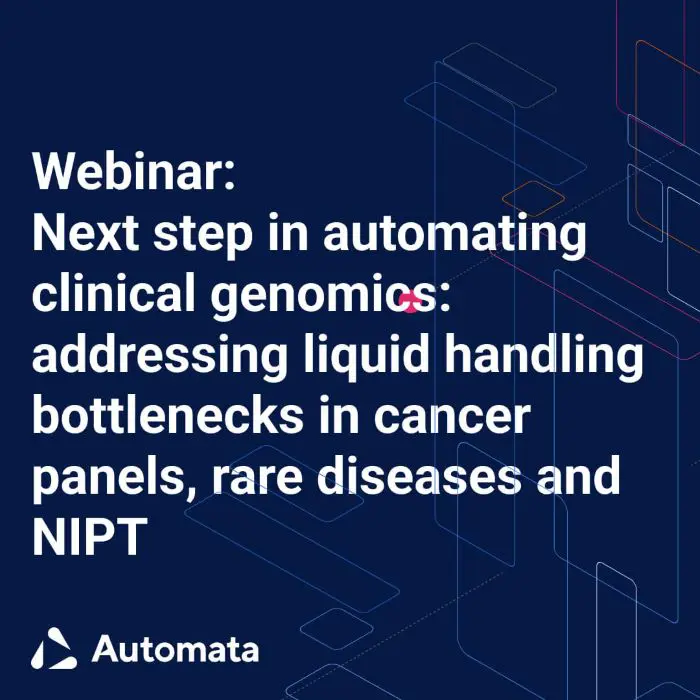

Improving lab workflows with automated NGS library preparation
Next-generation sequencing (NGS) was first introduced in 2000 by Lynx Therapeutics in the USA. Since then, rapid development and innovation in sequencing technologies have increased sequencing capacity and reduced sequencing costs to around $600 per genome according to Illumina (1). There are a variety of NGS technologies out there: Oxford Nanopore, PacBio, Illumina, Ion Torrent, each requiring a different NGS library preparation protocol. However, they all follow the basic principles of genomic library preparations.
Learn more about how Automata can help with automating NGS library preparation.
What is NGS library preparation?
Library preparations are the first step in NGS; handling samples to extract DNA, and transforming biological samples into libraries compatible with sequencing technology so sample DNA can be identified when sequenced. The main steps of library preparations are:
- DNA extraction
- Fragmentation of DNA (mainly used for short read sequencing or PacBio HiFi sequencing)
- Adapter ligations
- Library purification and quantification
The process varies from sample to sample and different genomic materials (DNA or RNA) require slightly different handling conditions. Therefore when manually handling multiple different samples, challenges can arise in their processing due to the variety of techniques and protocols which must be followed (2).
Challenges of manual NGS library preparation
It is well known that manual workflows are a time-consuming and laborious process in research. Library preparations are error-prone, due to the nature of the manual pipetting error and general human errors such as sample and reagent mix-ups. This can be timely and cost-inefficient, repeating sample processing for sequencing (3). In addition, the manual processing of samples is a bottleneck within itself, limited by the processing capacity of an individual that is unable to process samples to the same scale as robotic machinery. This further increases the hands-on time of staff as samples are processed in multiple small batches and by more than one person.
It can be difficult to maintain consistency in sample handling during library preparations which produce batches to batch variation, and when multiple staff are working on the same large sample set, the inconsistencies between batches are at risk of increasing. These small inconsistencies can lead to large errors or skew in data downstream of sequencing, reducing the accuracy and repeatability of the data (4).
Manual NGS Library preparations can lead to large revenue losses and time-consuming repeats. By incorporating automated NGS library preparation into protocols, risks of manual error are minimised leading to a streamlined library preparation which is cost-effective, efficient, and accurate in its output.
Benefits of automating NGS library preparation
Improving staff satisfaction: Library preparation automation offers the opportunity to overcome these challenges while improving the efficiency, reproducibility and accuracy of the process. Repetitive tasks are performed by automated tools, in parallel to staff working on alternative projects making the processing time efficient and increasing lab productivity.
Reliability and accuracy: The automated NGS library preparation workflows are more reliable and consistent, overcoming the nuances of manual pipetting errors and human error. Utilising automated liquid handling machines such as the Agilent Bravo, within Automata’s open, integrated automation solution, laboratories can increase the accuracy of the library preparation protocol, by reducing the number of human touchpoints making NGS libraries more reliably produced with less need for retesting.
Cost efficiency: By incorporating automated quality control (QC), automation has the potential to minimise reagent and supply waste, through auto-reporting of errors and terminating workflows if self-correction cannot be done (3). This process ensures cost efficiency, reducing revenue losses which benefits all Stakeholders within the company.
The accumulation of these benefits and handling large batch sizes highlights the potential improvements in the NGS library preparation experience if automation is introduced, where high throughput and rapid turnaround times can be achieved.
How can I improve my NGS Library preparation with automation?
Automated NGS library preparation benefits every level of the protocol, the easiest areas of library preparations to embed automation within are the initial sample handling for DNA extractions, and library purification and quantification. Library preparations can be partial or fully automated, to suit the needs of the laboratory. These protocols can be time and cost-efficient and produce better library quality and achieve consistent yields. Automation offers the opportunity to automate practically any NGS Library preparation workflow used today in the laboratory. With the demand for genomic research growing automation can provide a robust and reliable pipeline so laboratories can meet the needs of the growing consumer market.

Overcome Liquid Handling Bottlenecks in Genomics
Discover automation solutions for streamlining NGS workflows in cancer panels, rare diseases, and NIPT.
References:
- Preston J, VanZeeland A, Peiffer D. Innovation at Illumina: The road to the $600 human genome [Internet]. Nature.com. 2021 Available from: https://www.nature.com/articles/d42473-021-00030-9
- Mobley I. Sample Preparation for NGS – A Comprehensive Guide – Front Line Genomics [Internet]. Front Line Genomics. 2021 Available from: https://frontlinegenomics.com/sample-preparation-for-ngs-a-comprehensive-guide/
- Smith C. Improving NGS Library Prep with Automation [Internet]. Future Lab. 2022 [cited 16 October 2022]. Available from: https://www.biocompare.com/Editorial-Articles/583138-Improving-NGS-Library-Prep-with-Automation/
- The Top Ten Things That Can (and Do) Go Wrong with Manual Library Prep [Internet]. PerkinElmer Applied Genomics. Available from: https://perkinelmer-appliedgenomics.com/2020/03/02/things-that-can-and-do-go-wrong-with-manual-library-prep/